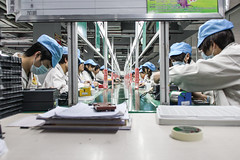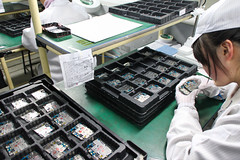Many of our electronic and electrical objects are ‘made in China’. Fairphone’s handsets are no exception and they write that ‘in 2015, 771.4 million smartphones were produced in China’ [1]. An article from the Economist of the same years states that 70% of mobile phones were manufactured in China [2]. These numbers were for me just abstract figures until I had a look at the photos and videos I am pointing out below. If you haven’t come across these yet, but own any kind of electronic good, then do have a look. There will be little commentary since what is described there – the scale of China’s manufacturing power – completely baffles me.
Fairphone 1 production line, Chongqing, China, 2013 © Fairphone
One of Fairphone’s four ethical goals is ‘Good Working Conditions’ [1]. They are aware that fast, affordable production often comes at the expense of the workforce and take a multi-stakeholder approach to improve working conditions in the factories producing their handsets. The video below is from a visit to the Fairphone 1 manufacturing plant in Chongqing in 2013 [3]. You will see a smiling, 23 year-old employee saying:
As the leader of the assembly line, working 10h30 a day is very normal, because we need to finish things up and it’s not that long.
This brought me back to the first time I saw images of production lines in China. I had come across Manufactured Landscapes, a 2006 documentary directed by Jennifer Baichwal on the work of landscape fine arts photographer Edward Burtynsky. The film focuses in particular on his journeys to China, documenting the country’s industrial revolution [4,5]. This is the trailer [6]:
Manufactured Landscape trailer, accessed via YouTube
Burtynsky’s photographs are stunningly beautiful, yet (I find) frightening - I thouroughly recommend browsing his website [7]. What haunts me when watching his images is the inhuman scale of the industrial project they depict. What also struck me very forcefully when watching Manufactured Landscapes is the utter meaninglessness of our consumerist society, which demands that irons be produced in vast quantities in a Chinese factory, only to return to China a few years later as part of a growing pile of electrical waste.
Burtynsky gave a TED talk [8], on Manufactured Landscapes (see also the related blog [9]):
Of course, do watch the whole half-an-hour or so. I would just like to point out a couple of frames relating to China and electronics.
Just before 18 minutes in, you can see a short video of one of the fastest assembly line workers in an electronics factory. And she is fast. Individuals there seem to merge into a robotic chain as their work demands they perform mindless repetitive tasks at speed. Burtynsky comments that taking a still shot was really challenging and that he needed to have the manager ask workers to actually freeze for a few seconds. Yet it seems that people are willing to populate those factories; to leave the countryside; to work long hours; to eat at the canteen – in 8 to 10 minutes, Burtynsky witnessed; to sleep in dorms.
Ed Burtynsky's TED prize acceptance talk, accessed via YouTube
Of course, do watch the whole half-an-hour or so. I would just like to point out a couple of frames relating to China and electronics.
Just before 18 minutes in, you can see a short video of one of the fastest assembly line workers in an electronics factory. And she is fast. Individuals there seem to merge into a robotic chain as their work demands they perform mindless repetitive tasks at speed. Burtynsky comments that taking a still shot was really challenging and that he needed to have the manager ask workers to actually freeze for a few seconds. Yet it seems that people are willing to populate those factories; to leave the countryside; to work long hours; to eat at the canteen – in 8 to 10 minutes, Burtynsky witnessed; to sleep in dorms.
Then 23 minutes in, images turn to recycling villages, where people are organised in small-scale family-sized workshops. There, workers burn the circuit boards on coal fires to extract the components and recycle the valued metals within, releasing toxic fumes in the process. Burtynsky says:
When you come into a town that actually does this kind of burning of the boards, you can smell it a good 5 or 10 kilometres before you get there.
Further on recycling, I found this picture gallery from the Guardian [10]. The images are Kai Loeffelbein’s photographs of e-waste recycling in Guiyu, southern China. The artisanal workshops pictured there have now been closed down to be replaced by an official recycling industrial park as China attempts to clamp down on pollution and turns towards addressing its own growing e-waste problems rather than treating imports. These are then channelled towards other countries, for the increasing amount of Western e-waste still needs outlets [11].
I do not know enough about the history of the Industrial Revolution to assess the extent to which what is happening in China echoes what happened in 18th and 19th century Europe. Yet my feeling is that the scale of the process in terms of size and speed is very different. And we shouldn't forget that this is a global process, a process driven by our seemingly bottomless need for consumer goods, by the increasingly powerful tools and techniques we have to access resources, by our economic system’s complete disregard for the finitude of the Earth. A mad and, if you look at it with some rationality, maddening process that we urgently need to reform if we are to survive the Anthropocene [12].
I shall certainly be keeping an eye on Burtynsky and Baichwal’s next collaboration [13].
I shall certainly be keeping an eye on Burtynsky and Baichwal’s next collaboration [13].
_______________________
[1] Fairphone. Good working conditions, www.fairphone.com. [Online]. Available: https://www.fairphone.com/en/our-goals/social-work-values/ [Accessed: 19th June 2018]
[2] Print edition| Leaders. "Made in China", The Economist, 3rd March 2015 [Online]. Available: https://www.economist.com/leaders/2015/03/12/made-in-china [Accessed: 19th June 2018]
[3] Fairphone video docummentary: First Fairphone production, December 2013. Available: https://vimeo.com/87670743 [Accessed: 19th June 2018]
[3] Fairphone video docummentary: First Fairphone production, December 2013. Available: https://vimeo.com/87670743 [Accessed: 19th June 2018]
[4] J. Baichwal, Director, Manufactured Landscapes [DVD]. New York: Zeitgeist Films; 2006.
[5] E. Burtynsky. Films, www.edwardburtynsky.com. [Online]. Available: https://www.edwardburtynsky.com/projects/films/manufactured-landscapes [Accessed: 19th June 2018]
[5] E. Burtynsky. Films, www.edwardburtynsky.com. [Online]. Available: https://www.edwardburtynsky.com/projects/films/manufactured-landscapes [Accessed: 19th June 2018]
[6] Manufactured Landscapes trailer, YouTube, published by YouTube movies on 3rd August 2011 [Online]. Available: https://www.youtube.com/watch?v=KVybNCPzG7M [Accessed: 19th June 2018]
[7] E. Burtynsky. https://www.edwardburtynsky.com/ [Online]
[7] E. Burtynsky. https://www.edwardburtynsky.com/ [Online]
[8] Edward Burtynsky: Manufactured Landscapes, YouTube, published by Ted on 15th April 2008 [Online]. Available: https://www.youtube.com/watch?v=U2Dd4k63-zM [Accessed: 19th June 2018]
[9] L. Jacobs. "Gallery: Edward Burtynsky's extraordinary images of manufactures landscapes", TEDBlog, https://blog.ted.com/ [Online]. Available: https://blog.ted.com/gallery-edward-burtynskys-extraordinary-images-of-manufactured-landscapes/
[Accessed: 19th June 2018]
[9] L. Jacobs. "Gallery: Edward Burtynsky's extraordinary images of manufactures landscapes", TEDBlog, https://blog.ted.com/ [Online]. Available: https://blog.ted.com/gallery-edward-burtynskys-extraordinary-images-of-manufactured-landscapes/
[Accessed: 19th June 2018]
[10] A. Leach. "The e-waste mountain in pictures", The Guardian, 18th October 2016 [Online]. Available: https://www.theguardian.com/global-development-professionals-network/gallery/2016/oct/18/the-e-waste-reduce-waste-old-technology-mountains-in-pictures [Accessed: 19th June 2018]
[11] M.Standaert. "China's Notorious E-Waste Village Disappears Almost Overnight", Bloomberg News , 17th December 2015 [Online]. Available: https://www.bna.com/chinas-notorious-ewaste-n57982065266/ [Accessed: 19th June 2018]
[12] J. Stromberg. "What is the Anthropocene and Are we In It", Smithsonian Magazine, January 2013. Available: https://www.smithsonianmag.com/science-nature/what-is-the-anthropocene-and-are-we-in-it-164801414/ [Accessed: 19th June 2018]
[13] E. Burtynsky, J Baichwal & N. De Pencier, The Anthropocene Project [Online]. Available: https://theanthropocene.org/ [Accessed: 19th June 2018]
[13] E. Burtynsky, J Baichwal & N. De Pencier, The Anthropocene Project [Online]. Available: https://theanthropocene.org/ [Accessed: 19th June 2018]


